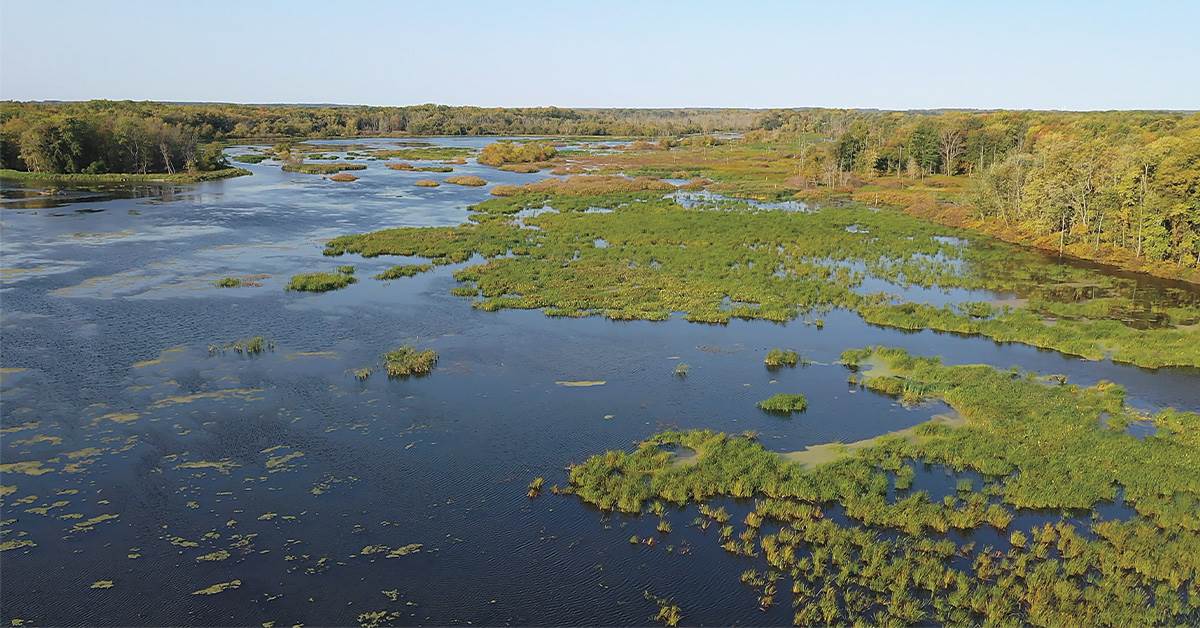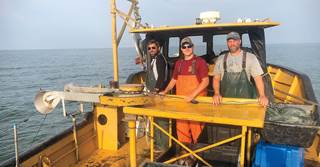Harnessing the power of wetlands to improve water quality and wildlife habitat in the Great Lakes

Nearly 20,000 years ago, mountains of ice more than a mile thick began retreating across what is now Canada and the northern tier of the United States. As the climate warmed and the ice sheets melted, water filled the glaciers’ giant footprints, forming the Great Lakes. Today, the lakes encompass more than 10,000 miles of coastline and hold approximately 20 percent of the world’s freshwater—the largest repository of this precious natural resource on earth. The Great Lakes are also the lifeblood of a unique ecosystem, supporting 3,500 species of plants and animals and some 48 million people in the United States and Canada.
As in many other regions, wetlands, which remove nutrients and other pollutants from runoff, play a crucial role in maintaining water quality in the Great Lakes. Unfortunately, more than 60 percent of the region’s historical wetlands have been degraded or converted to other uses, and those that remain are threatened by development, climate change, and invasive species. “It’s a dynamic system that’s constantly changing,” says Jason Hill, director of conservation programs in DU’s Great Lakes/Atlantic Region. “There’s a lot of water, but the land has been altered and it’s difficult to manage.”

A kayaker enjoys Sheboygan Marsh in Western Wisconsin.
Photo © Chris Sebastian, DU
A high-priority conservation area for DU in the Great Lakes watershed is the western Lake Erie basin, an intensively developed region where maintaining clean drinking water supplies is a serious concern. In northwest Ohio’s Carroll Township, for example, residents depend on a municipal water plant that draws 1 million gallons of water per day from a pipe extending into Lake Erie. To help safeguard the township’s water, plant superintendent Henry Biggert and his staff regularly monitor water samples for a range of impurities.
“Sometimes [water quality] stays consistent, but depending on wind and rain events, the situation can change quite significantly and quite fast,” Biggert says.
One of those significant events occurred on a hot summer day in 2013, when Biggert’s team detected dangerous levels of toxins in the water supply produced by a massive bloom of blue-green algae in Lake Erie. That forced Biggert to shut down the water treatment plant for two days while the system was flushed out, forcing residents to rely on bottled water until the plant was back online. The event was a wake-up call for municipalities across the region that rely on Lake Erie for their drinking water.
Several factors cause harmful algae blooms, including excess levels of fertilizer that wash into lakes and rivers from agricultural fields and residential lawns. Wetlands help remove these pollutants before they enter waterways, but in areas like the western Lake Erie basin, where more than 90 percent of historical wetlands have been lost, not enough wetlands are left on the landscape to do the job.
To help improve water quality in his state, Ohio Governor Mike DeWine recently launched the H2Ohio Initiative to reduce harmful algae blooms, improve wastewater infrastructure, and prevent lead contamination. A central component of the $172 million plan is the restoration and enhancement of wetlands. Ducks Unlimited has joined the Ohio Department of Natural Resources and more than 40 other organizations to help implement H2Ohio. “We appreciate Ducks Unlimited, a recognized leader in wetland conservation, for their partnership in support of this critically important endeavor,” DeWine said.
The H2Ohio program has allocated $7.9 million to DU in support of seven wetland conservation projects. “H2Ohio is unlike anything the state has ever seen in terms of a financial investment in water quality and habitat,” says Russ Terry, DU’s regional biologist in Ohio.
DU is also conducting research to help maximize the wildlife and water-quality benefits of its wetland conservation work. With support from a $1 million grant from Denise and Dave Bunning through the Chicago-based Sunshine Charitable Foundation, DU has joined several partners to study how wetland restoration reduces agricultural phosphorus runoff that is fueling harmful algae blooms in Lake Erie. This research will evaluate how much phosphorus is being removed by wetlands on several previously restored DU projects and will develop a model to help target future wetland conservation projects in the region.
Biggert, a longtime DU member and volunteer, welcomes any help nature can provide. “In the last 15 years, I’ve come to realize the impacts that wetlands can have on nutrient removal. I feel that is the answer. We can do our best to remove [pollutants] here at the plant, but even if we were perfect, we couldn’t keep them all out.”

(From left) Todd Stuth, his son Finn Stuth, and Mike Warwick work as commercial fisherman on Lake Erie. Wetland restoration helps improve water quality, which is vital to healthy fisheries.
Photo © Todd Stuth
According to Michigan Sea Grant, the Great Lakes support more than 1.3 million jobs in the United States, which generate $82 billion in wages annually. This includes commercial, recreational, and tribal fisheries, collectively valued at more than $7 billion annually. Wetlands play an important role in supporting these fisheries and other wildlife, both by keeping water clean and by providing habitat for a variety of fish species.
Todd and Carin Stuth are fourth-generation owners of Baileys Harbor Fish Company in northwest Wisconsin’s Door County. Their fleet operates year-round, harvesting whitefish and perch in Green Bay and offshore in Lake Michigan. Every day their crews see the benefits of wetlands conservation.
“We can’t say enough about wetland preservation,” Todd Stuth says. “Wetlands create fish spawning habitat and filter runoff. Conservation efforts in Lower Green Bay and along the lakeshore have definitely helped our watershed.”
Outdoor recreation is another important driver of the economy in the Great Lakes region. Ed Farley, DU’s regional biologist in New York, says DU projects along the shores of Lake Ontario have received greater public use during the pandemic. “Coastal marsh enhancements have recreational value for hunting, fishing, kayaking, bird-watching, and a lot more,” he says. “We are doing work next to Rochester and Buffalo, and these conservation projects are drawing a lot of people from these urban areas.”
DU is also working to restore small interior wetlands in the Great Lakes region, which provide important recreational and water-quality benefits. In 2018, DU formed a partnership with the USDA Natural Resources Conservation Service (NRCS) in Wisconsin to help deliver and monitor Wetland Reserve Easements on private lands. In just two years, the partnership has completed 25 projects and protected, enhanced, or restored 8,250 acres across the state, says Brian Glenzinski, DU regional biologist in Wisconsin. “Easements are a natural solution for landowners looking to retire ground that might not be productive for farming,” he says. “Interest in this program is high among producers.”
As an added benefit, many easements that were originally secured on private lands have been purchased by the state and now provide public access for outdoor recreation. A good example is Paradise Valley Wildlife Area in Waukesha County. The NRCS and the Wisconsin Department of Natural Resources originally restored wetlands on the property in partnership with a private landowner. Today, DU is helping to maintain this important 1,500-acre public outdoor recreation area by repairing berms and installing spillways to keep out an influx of invasive carp.

Photo © DAVIDSTIMAC.COM
Among the greatest conservation challenges facing DU and its partners in the Great Lakes region is rapidly fluctuating water levels. Not even a decade ago, shoreline property owners faced record-low water levels, but over the past two years the lakes have surged to record highs. These shifts mean that large wetland restoration projects in coastal areas must be designed to function in a wide range of conditions.
“We are insulated from sea-level rise,” Hill says, “but we still have to contend with many of the same challenges associated with managing large coastal systems. During severe storms, water levels can rise two to three feet in one day. Coupled with record-high lake levels, our conservation projects get hammered by large volumes of water.”
That’s why DU prepares for the worst when planning wetland restoration work on the Great Lakes. These preparations paid off in Michigan during the spring of 2020, when two dams failed following torrential rainfall, causing extreme flooding and forcing more than 10,000 people from their homes in Edenville, Sanford, and Midland. As floodwaters raced toward Saginaw Bay and surrounding communities, managers at the Shiawassee National Wildlife Refuge sprang into action. In 2016, DU had helped the US Fish and Wildlife Service restore more than 1,000 acres of wetlands on former agricultural lands on the refuge. The Maankiki Marsh project reconnected nearly two square miles of drained land to the adjacent Shiawassee River for the first time in more than a century. That connection proved invaluable over that Memorial Day weekend.
“It was a 500-year flood event, so we made the decision to open Maankiki Marsh,” says refuge manager Eric Dunton. “That added more than 1,000 acres of flood-storage capacity, and every bit of that was needed.”
The entire 10,000-acre refuge was eventually flooded in 10 feet of water. The ability to safely hold that volume of water reduced the flooding suffered by neighboring landowners and communities.
During the past decade alone, DU has conserved more than 60,000 acres of wetlands and associated wildlife habitat in the Great Lakes region. Moving forward, government programs like the Great Lakes Restoration Initiative, along with ongoing support from DU members and corporate partners such as Cargill and Energy Transfer, will enable DU to conserve an additional 10,000 acres per year.
“Clean water is truly the lifeblood of people and wildlife in the Great Lakes,” Hill says. “Fortunately, growing numbers of people recognize that wetlands conservation is an important part of the solution to keeping the lakes and our water clean. DU is working hard throughout this important region to provide the best habitat possible for waterfowl and to ensure a healthy future for people and wildlife.”
Ducks Unlimited uses cookies to enhance your browsing experience, optimize site functionality, analyze traffic, and deliver personalized advertising through third parties. By continuing to use this site, you agree to our use of cookies. View Privacy Policy